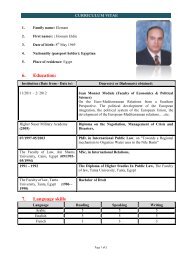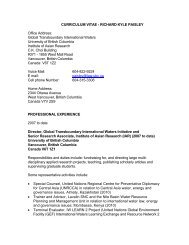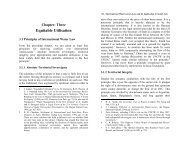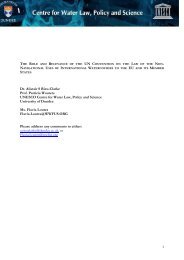Upreti, Trilochan, International Watercourses Law and Its Application ...
Upreti, Trilochan, International Watercourses Law and Its Application ...
Upreti, Trilochan, International Watercourses Law and Its Application ...
Create successful ePaper yourself
Turn your PDF publications into a flip-book with our unique Google optimized e-Paper software.
Introduction / 3 4 / <strong>International</strong> <strong>Watercourses</strong> <strong>Law</strong> <strong>and</strong> <strong>Its</strong> <strong>Application</strong> in South Asiahave become more extreme <strong>and</strong> dramatic in theirconsequences. 12The water going out from the surface of the earth must comeback in equal amounts - a perpetual cycle with no beginning,middle or end. In other words, the watercourse system is anelement of the hydrological cycle, which consists of theevaporation of water into the atmosphere, chiefly from theoceans, <strong>and</strong> its return to earth through precipitation <strong>and</strong>condensation. 13 The volume of groundwater is large <strong>and</strong> coversa significant quantity of the freshwater system, 14 however, theinternational community (IC) has not agreed upon a setframework of rules on groundwater <strong>and</strong> there are several issuesthat need to be resolved before such rules will be acceptable toall states. 15 As McCaffrey rightly observed, the area ofgroundwater is still in a primary <strong>and</strong> inchoate stage:"as such, the law of international groundwater may onlybe said to be, in the embryonic stages of development, .... but this situation should prevail only until a specialregime can be tailored for international groundwater". 16falls as a result of rain, snow <strong>and</strong> precipitation, which flows over thesurface to percolate into the ground, ground water emerging intostreams <strong>and</strong> moving within aquifers. In this sense, the relation ofground water <strong>and</strong> surface water is inextricably interlinked. Thus, thetotal quantity of water has remained stable over the billions of years.12 N. A. Robinsion (ed), IUCN Environmental Policy & <strong>Law</strong> paper No27: Agenda 21: Earth's Action, New York: Oceana Pub. , 1993, p. 357.13 Supra note 11, p 20.14 Ibid. p. 6, 97% of freshwater remains as groundwater.15 Supra note 10, state practice suggests different practices on groundwater, for example, the USA <strong>and</strong> Canada deliberately rejected theconcept of the unity of a drainage basin for which boundary waterswere separated from tributary waters flowing into boundary waters.Although, equitable utilisation is the applicable rule on groundwater,the Helsinki Conference placed groundwater at the head of the lists ofsubject that it recommended for further study by the ILA. pp. 299, 274& 269.16 Supra note 6, p. 433.Eventually, it appears that until the full regime is developed onthe issues, groundwater is covered by the rules of equitableutilisation adopted in the UN Convention on the Non-Navigable Uses of <strong>International</strong> <strong>Watercourses</strong> (UNCIW). 17Regardless of the definition of a watercourse (WC) in the 1997UN convention, which includes groundwater, 18 there is still alot that needs to be done in order to obtain an agreeable formulaon the issue. With regard to the lack of freshwater, Falkennarhas distinguished four different causes of water scarcity 19 :aridity, drought, desiccation, <strong>and</strong> water stress.1.2 Uneven Availability <strong>and</strong> ScarcityIn order to accrue optimum benefits from an <strong>International</strong>Watercourse (IWC) it must be developed in a holistic,integrated manner, considering the whole length of awatercourse as a unit. This fact itself highlights the significanceof riparian co-operation in order that maximum benefits can beaccrued from an IWC due to its geographical <strong>and</strong> hydrologicalcircumstance, e.g., a good site to construct a reservoir lies inone country (Nepal), but such augmented water can be used inanother country (India); flood damage can be prevented (India<strong>and</strong> Bangladesh), <strong>and</strong> hydropower plants can be constructed inother countries (in Nepal <strong>and</strong> India). Geography <strong>and</strong> hydrologydetermine this fact. In fact Nepal owns magnificent gorgeswhere high dams can be built <strong>and</strong> the Himalayan waters stored,but such sites are not available in India, Bhutan <strong>and</strong>17 Ibid.18 "Watercourse" means a system of surface waters <strong>and</strong> groundwaterscontributing by virtue of their physical relationship a unitary whole <strong>and</strong>normally flowing into a common terminus. Article 2 (a) of 1997UNCIW, 36 ILM (1997), p. 700.19 R. Clarke, Water: the <strong>International</strong> Crisis, London: Earthscan Pub.,1991, p. 2, as quoted to Malin Falkner from Stockholm's NaturalScience Research Council.












